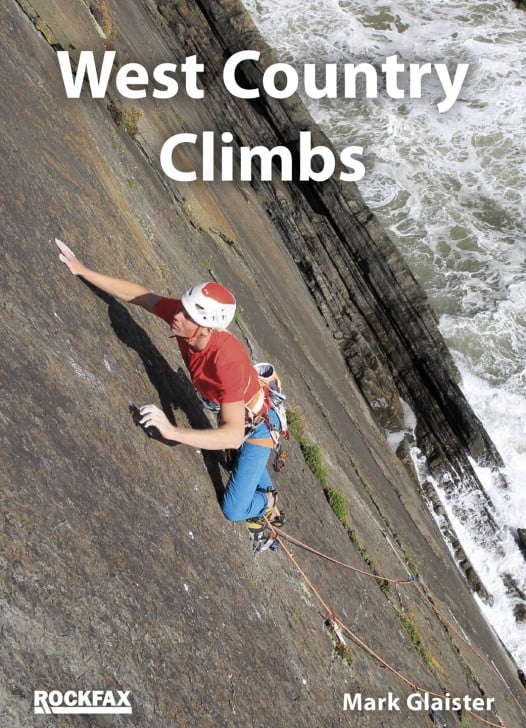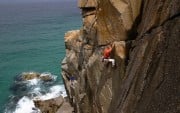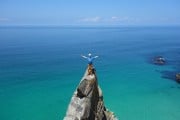There are a couple of types of incentives that motivate people to get into climbing or rock climbing. Broadly speaking, one is an interest in mountain activities, and the other, in challenging physical moves.
In the ancient days, there used to be only the former, in a way. However, since Walter Parry Haskett Smith's historic ascent of The Wasdale Crack (HS 4c) at The Napes marked the birth of rock climbing as a sport on its own right — so to speak — climbing has evolved a long way. Nowadays, more people may take on climbing because they are attracted by challenging physical moves, rather than for a love of the great outdoors.
My background is definitely the former. I started with mountain walking and scrambling in Japan, particularly fascinated with exposed high-ridge scrambling in the Japanese Alps.
I eventually joined a mountain-lovers club in 2000 and took on climbing, partly because I was keen to learn rope-work skills, after I had had enough of super-scary solo scrambling with no back-up safety.
I was taught climbing by the club's seniors on the rock and in the mountains from day one. I remember a senior climber saying, "I don't understand why some people would like to build home walls with plastic. I would get bored immediately". Basically, a popular view was that climbers should spend as much available time as possible in mountains to do mountaineering. I accepted it without question.
Moving to the UK, however, drastically changed my view of climbing, and even my life. I was immediately hooked on trad climbing, and began climbing shorter routes with more physically challenging moves.
My old preference remained, though. In my early days, while I was enjoying single-pitch trad, I missed longer multi-pitch routes. My stomping ground at the time, Peak Grit, did not have a great deal to offer in this regard, and the fact that my most favourite routes in my early days were Valkyrie (VS 4c) at The Roaches and Central Climb (VS 4c) at Hen Cloud was telling — both are rather rare multi-pitch grit routes. I loved Crib Goch in Snowdonia, too, even though it was mere grade-1 scrambling. I am sure I am not alone here. The fact that there are great many ridge-climbing and mountaineering guidebooks, including ones by my climbing partner - UKC/UKH's Dan Bailey - supports it!
So on my early visit to Cornwall, when a few of our group suggested Bosigran Ridge a.k.a Commando Ridge (VD), I remember the plan immediately interested me. It is a 200-metre ridge route — an ideal offering to me!
The last part of the approach to Bosigran Ridge is not a path. You need a bit of navigation to find the best way down, and some opt to abseil in for the steepest section. In a way, the slight awkwardness helps build up expectation before the climb has even started.
In addition, there is a unique focal point for this ridge, often dubbed 'Commando Ridge'. That is, an old memorial plaque is secured to one side of the ridge because, as quoted in the oldest climbing guidebook of the area published in 1950:
'It was one of the climbs used for Commando training in World War II'
One of the authors of the book, A. W. Andrews, is responsible for the first ascent of the ridge in 1902, and memories of commando training must have been fresh at the time. Many decades later, you can still feel this history during the approach - as an added bonus!
The culmination of this building expectation ahead of starting the route is the exposed, final scrambling step to come around the rock ridge onto a narrow platform, the first belay, located at the very end of the ridge.
The platform is conveniently situated slightly above sea level at any tide. Still, you wouldn't wish to fall into the waves, which crash on the rocks below at irregular intervals. I am sure guides are inclined to belay their inexperienced clients at the final step.
It is an awe-inspiring (literally) little place. The pre-climb excitement is what all the best mountain ridges should have, and Bosigran Ridge has plenty of it, even though it is not a mountain ridge but one at sea-level that protrudes amazingly out into the waves. Whilst the approach starts with a pastoral and peaceful Cornish landscape at Count House, as you get nearer the bottom of the ridge, you quickly realise it is a serious undertaking.
The first pitch, climbing up from the confined space of the narrow platform, meets this expectation of a 'serious undertaking'. Apart from the optional and easily avoidable The Armchair (HVS 5a) at the very end of the eight pitch route, I think this is the crux of the whole ridge.
The exposure of the first pitch is fantastic, especially when the sea is a little rough, and it is indeed exhilarating to climb up to the bright, sun-lit narrow ridge from a dingy little platform right above the water. Such a feeling is usually reserved for a remote mountain area, but here in Bosigran, you can get it without investing quite as much effort or time!
Then, the traverse proper begins, which is as good as a trad VDiff can be, with tremendous exposure on both sides of the ridge, but with excellent traditional protection the whole way, whether you pitch or move together. Although the ridge is not 100 metres high above the ground, it is high enough that your instinct tells you that falling unroped would be pretty messy, so if exposure is an important aspect of climbing, then Bosigran Ridge has a lot to offer!
I enjoyed every moment of the climb on my first visit. Since then, I climbed it several times, and it is perhaps my most repeated route in the country, despite the fact I have never lived anywhere remotely close to Cornwall. Almost every time I went to Cornwall with moderate climbers who had never been, Bosigran Ridge was my top recommendation, and I too was sometimes their company.
Among my many good memories on the ridge, one with my late friend Loz Kissoon stands out. He absolutely loved climbing, yet the places he could visit were limited due to his serious chronic lung disease, which ultimately took his life years later. Although he would have loved to do mountain climbing, he would have had no chance with a walk-in. Bosigran Ridge was an ideal destination for him, as the approach involves zero climbing UP! There, he sampled the best mountain-ridge equivalent that he could, all under his own steam.
I cannot recommend Bosigran Ridge enough to any climber, including modern-move-oriented climbers with limited outdoor experience. Bosigran Ridge may not be a testing ground for well-honed climbing techniques — it is VDiff after all. However, the ridge is definitely not ground a complete novice can stray into, so be safe!
Regardless of one's climbing grade, climbers can celebrate on this route what a human can achieve on formidable-looking terrain, surrounded by beautiful Cornish scenery. On Bosigran Ridge, they can sample every good thing a day's mountain climbing provides, except for the long arduous approach, the logistical difficulty, and the loose rock masochistically sought after by some.
I have many fond memories of the route which have long stayed with me, and surely will for many more years.
Guidebook

West Country Climbs
The West Country is home to some of the finest sea cliffs in the country plus many varied inland crags offering an almost unrivaled variety of climbing styles and rock types. Traditional and sport limestone around the Bristol area, beautiful slabs of the Culm Coast, epic big cliffs on the Atlantic Coast, immaculate granite at West Penwith and on The Lizard, the stunning tors of Dartmoor, and more spectacular limestone around Torbay.
The new edition of this best-selling book to the superb climbing in the southwest of England. The book builds on the extensive coverage of its predecessor with many new crags and routes added....
More info























Comments
Lovely. Agree with every word and sentiment in this!
A classic route that never fails to be a great time. Squeezing around just before the tide cut off the starting ledge and consequently getting drenched by a rogue wave was definitely memorable, as was watching perfect swell waves roll in to the cove on a warm April evening.
A correction to the article: The Armchair is on Raven Wall on the main Bosi cliff, not on the ridge.
Great article Masa!
Thank you for your comment! There is the HVS route The Armchair (HVS 5a) on the main cliff, but the steep step (4b/4c) in the (avoidable) last pitch on Bosigran Ridge a.k.a Commando Ridge (VD) is also (confusingly?) called The Armchair according to the CC definitive guidebook (2000).
I’ve never climbed this before, not even solo but after reading that I’m going to get to it, probably with my lads. Thanks a lot.